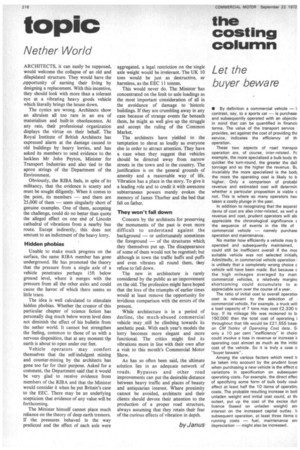topic
Page 216

If you've noticed an error in this article please click here to report it so we can fix it.
Nether World
ARCHITECTS, it can easily be supposed, would welcome the collapse of an old and dilapidated structure. They would have the ,opportunity of earning their living by designing a replacement. With this incentive, they should look with more than a tolerant eye at a vibrating heavy goods vehicle which literally brings the house down.
The cynics are wrong. Architects show an altruism all too rare in an era of materialism and built-in obsolescence. At any rate, their professional organization displays the virtue on their behalf. The Royal Institute of British Architects has expressed alarm at the damage caused to old buildings by heavy lorries, and has asked its members to send evidence to the luckless Mr John Peyton, Minister for Transport Industries and also tied to the apron strings of the Department of the Environment.
Obviously, the RIBA feels, in spite of its militancy, that the evidence is scanty and must be sought diligently. When it comes to the point, its members — and there are 25,000 of them — seem singularly short of genuine examples. One of them, accepting the challenge, could do no better than quote the alleged effect on one end of Lincoln cathedral of vibrations from a nearby bus route. Except indirectly, this does not amount to an indictment of the heavy lorry.
Hidden phobias
Unable to make much progress on the surface, the same RIBA member has gone underground. He has promoted the theory that the pressure from a single axle of a vehicle penetrates perhaps 15 et below ground level, where it merges with the pressure from all the other axles and could cause the havoc of which there seems so little trace.
The idea is well calculated to stimulate hidden phobias. Whether the creator of this particular chapter of science fiction has personally dug much below worm level does not diminish the effect of his bulletin from the nether world. It cannot but strengthen the feeling, common to those of us with a nervous disposition, that at any moment the earth is about to open under our feet.
Vehicle operators may comfort themselves that the self-indulgent mining and counter-mining by the architects has gone too far for their purpose. Asked for a comment, the Department said that it would be very glad to receive evidence from members of the RIBA and that the Minister would consider it when he put Britain's case to the EEC. There may be an underlying scepticism that evidence of any value will be forthcoming.
The Minister himself cannot place much reliance on the theory of deep earth tremors. If the pressures behaved in the way predicted and the effect of each axle were aggregated, a legal restriction on the single axle weight would be irrelevant. The UK 10 tons would be just as destructive, or harmless, as the EEC 11 tonnes.
This would never do. The Minister ' has concentrated on the limit to axle loadings as the most important consideration of all in the avoidance of damage to 'historic buildings. If they are crumbling away in any case because of strange events far beneath them, he might as well give up the struggle and accept the ruling of the Common Market.
The architects have yielded to the temptation to shout as loudly as everyone else in order to attract attention. They have a case when they suggest that vehicles should be directed away from narrow streets in the town and in the country. The justification is on the general grounds of amenity and a reasonable way of life. Vibration has a place in the story. To give it a leading role and to credit it with awesome subterranean powers merely evokes the memory of James Thurber and the bed that fell on father.
They won't fall down Concern by the architects for preserving the monuments of the past is even more difficult to understand against the background — or unfortunately sometimes the foreground — of the Structures whicll they themselves put up. The disappearance of some of them would not be regretted; but although in town the traffic huffs and puffs and even vibrates all round them, tkey refuse to fall down.
The new in architecture is rarely considered by the public as an improvement on the old. The profession might have hoped that the loss of the triumphs of earlier times would at least remove the -opportunity for invidious comparison with the errors of the present.
While architecture is in a period of decline, the much-abused commercial vehicle may ,still be climbing towards its aesthetic peak. With each year's models the lorry becomes more elegant and more functional. The critics might find its vibrations more in line with their own after a visit to this month's Commercial Motor Show.
As has so often been said, the ultimate solution lies in an adequate network of roads. Bypasses and other road improvements can put the desirable distance between heavy traffic and places of beauty and antiquarian interest. Where proximity cannot be avoided, architects and their clients should devote their attention to the production of a proper road structure, always assuming that they retain their fear of the curious effects of vibration in depth.
by Janus
































































































































































































































































































































































































































































































































